You’ve probably experienced that frustrating moment when your WiFi signal drops the instant you step outside. Whether you’re trying to stream music during a barbecue or check emails on your patio, weak outdoor connectivity can seriously limit how you use your backyard space. Traditional routers simply weren’t designed to penetrate walls and maintain strong signals across outdoor areas, but there’s a solution that’s transforming how homeowners think about their entire property’s connectivity.
Understanding the Need for Outdoor WiFi Coverage
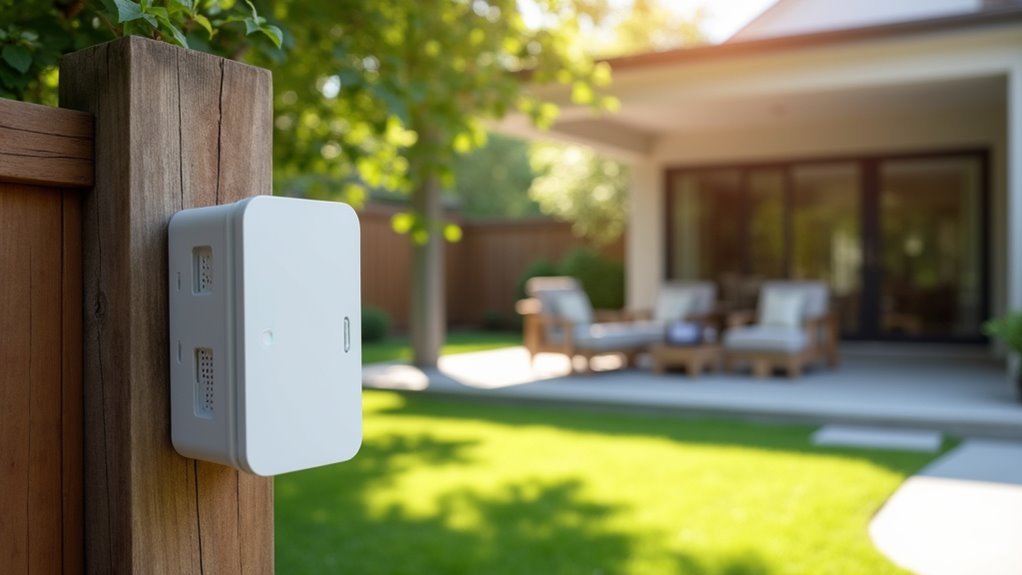
As outdoor living spaces like patios, decks, and gardens become central to modern home life, your need for reliable WiFi coverage extends far beyond your interior walls.
Traditional routers often can’t penetrate through walls effectively, creating frustrating dead zones in your backyard where you want to stream entertainment or work remotely.
Dead zones in your backyard disrupt streaming and remote work when traditional routers fail to penetrate walls effectively.
With over 20 connected devices in the average home, your outdoor WiFi must support smart home applications and entertainment systems seamlessly.
You’re likely experiencing weak signals that interrupt video calls, buffer streaming services, or disconnect your smart outdoor devices.
These connectivity gaps highlight why mesh WiFi systems have become essential for modern homeowners who refuse to compromise on internet performance when enjoying their outdoor spaces.
What Is Mesh Wifi Technology
You’ve likely heard about mesh WiFi, but understanding how it actually works will help you make the right choice for your network expansion.
Mesh systems operate differently than traditional routers by creating a web of interconnected devices that communicate with each other to blanket your property in seamless coverage.
Let’s explore how these networks function, how they compare to conventional setups, and how they manage to keep you connected as you move throughout your space.
How Mesh Networks Work
Traditional WiFi setups force you to deal with frustrating dead zones and weak signals in certain areas of your home, but mesh technology solves this problem by creating a unified network of interconnected devices.
Your mesh system distributes the signal evenly throughout your property by connecting satellite nodes to your main router. Each satellite communicates with both the router and other nodes, creating multiple pathways for data transmission.
As you move around, your devices automatically connect to the strongest available signal without interruption. This seamless handoff lets you extend your WiFi range into outdoor spaces, providing reliable WiFi coverage outdoors.
The tri-band or quad-band capabilities guarantee multiple devices maintain peak speeds simultaneously, eliminating the congestion that plagues traditional routers.
Mesh Vs Traditional Routers
When choosing between mesh WiFi and traditional routers, you’ll notice fundamental differences in how they deliver internet coverage throughout your space.
Traditional routers broadcast from a single point, creating frustrating dead zones that leave you disconnected when you need internet most.
Mesh systems are expandable networks that use multiple access points to extend the Wi-Fi signal throughout your entire property, maintaining consistent WiFi signal strength everywhere.
Here’s what makes mesh networks superior for outdoor expansion:
- No more dead zones – enjoy seamless connectivity from your kitchen to your garden
- Automatic handoffs – your devices connect to the strongest signal without interruption
- Consistent performance – stream movies on your patio without buffering frustrations
Mesh systems eliminate the limitations that make traditional routers inadequate for extensive coverage.
Coverage and Signal Handoff
Although traditional routers struggle with signal distribution across large spaces, mesh WiFi technology revolutionizes coverage through its intelligent network of interconnected devices. You’ll experience seamless signal handoff as your devices automatically connect to the strongest mesh satellites while moving throughout your property.
| Feature | Traditional Router | Mesh System |
|---|---|---|
| Coverage Area | Limited, single point | Expandable, multiple points |
| Signal Handoff | Manual reconnection | Automatic switching |
| Dead Zone Elimination | Requires extenders | Built-in satellite placement |
For ideal placement and outdoor WiFi extension, position satellites near windows or exterior walls. This strategic arrangement guarantees reliable WiFi signal penetration to your backyard, eliminating connectivity gaps. Each satellite communicates with others, creating unified coverage that adapts to your movement patterns throughout indoor and outdoor spaces.
Eliminating Dead Zones in Your Garden and Patio
Since outdoor spaces like gardens and patios often suffer from weak WiFi signals, mesh WiFi systems provide the perfect solution to extend your network coverage beyond your home’s walls.
By strategically placing satellite nodes near windows or exterior walls, you can eliminate frustrating dead zones that prevent you from enjoying seamless connectivity in your backyard.
Transform your outdoor experience with these game-changing benefits:
Transform your connectivity with revolutionary mesh technology that eliminates dead zones and delivers seamless internet throughout your entire outdoor living space.
- Stream your favorite shows while relaxing on your patio without buffering interruptions
- Stay connected during outdoor gatherings with reliable internet access for all your guests
- Control smart home devices like outdoor security cameras and lighting systems effortlessly
Each satellite communicates with your main router and other nodes, creating a unified network that guarantees consistent signal coverage throughout your entire outdoor space, making dead zones a thing of the past.
Benefits of Outdoor Mesh WiFi Systems
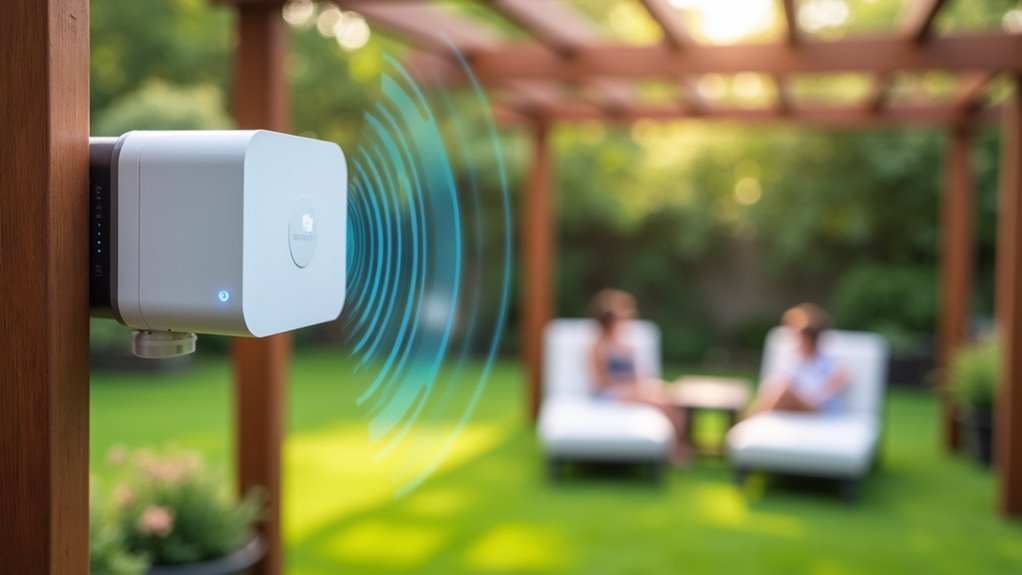
You’ll experience uninterrupted connectivity as you move from your living room to your backyard, thanks to outdoor mesh systems that create a unified network throughout your property.
These systems withstand rain, snow, and extreme temperatures with their weather-resistant designs, ensuring your network stays online regardless of conditions.
Your smart home devices, from outdoor security cameras to pool automation systems, will maintain strong connections across even the most challenging outdoor environments.
Seamless Indoor-Outdoor Connectivity
When you step from your living room onto your patio, your devices shouldn’t struggle to maintain connection. Outdoor mesh systems create truly seamless WiFi that follows you everywhere, eliminating the frustration of dropped calls and buffering videos.
With automatic configuration through apps, you’ll move freely between spaces without manually switching networks.
Your connected devices benefit from:
- Uninterrupted streaming – Watch movies poolside without worrying about signal drops ruining the moment
- Reliable security monitoring – Keep your family safe with outdoor cameras that maintain constant connectivity
- Effortless smart home control – Adjust lighting and temperature from anywhere in your yard
The weatherproof enclosure protects your investment while delivering consistent WiFi outdoors.
This technology transforms your entire property into one connected ecosystem, supporting over 150 simultaneous connections for ultimate convenience.
Weather-Resistant Network Performance
While indoor routers struggle against weather elements, outdoor mesh systems thrive in conditions that would destroy standard equipment. You’ll find these weather-resistant units feature IP65 or IP68 ratings, protecting against dust, moisture, and shock in demanding outdoor environments.
| Feature | Standard Router | Outdoor Mesh |
|---|---|---|
| Weather Protection | None | IP65/IP68 rated |
| Coverage Range | 150 feet | 2,500 feet |
| Device Capacity | 50 devices | 150+ devices |
| Power Options | AC only | PoE supported |
Advanced access points deliver reliable performance while providing extensive coverage across your entire property. You’ll enjoy seamless connectivity for over 150 devices simultaneously, supporting everything from smart irrigation systems to outdoor entertainment setups. PoE capabilities eliminate separate power requirements, giving you flexible installation options throughout your backyard.
Enhanced Smart Device Coverage
As smart home technology expands beyond your house’s walls, outdoor mesh WiFi systems like the NETGEAR Orbi become essential for maintaining reliable connections to devices scattered across your property.
With coverage extending seamlessly to your backyard, you’ll guarantee your smart devices maintain consistent connectivity regardless of their location.
These powerful systems deliver exceptional benefits:
- Support 150+ devices simultaneously – Never worry about overloading your network when multiple smart devices operate outdoors.
- Maintain high speeds with tri-band technology – Stream security footage and conduct video calls without frustrating interruptions.
- Weather-resistant design withstands harsh conditions – Your investment stays protected with IP65-rated durability against dust and moisture.
Your outdoor smart devices deserve the same reliable performance you expect indoors.
Weatherproof Hardware for Outdoor Environments
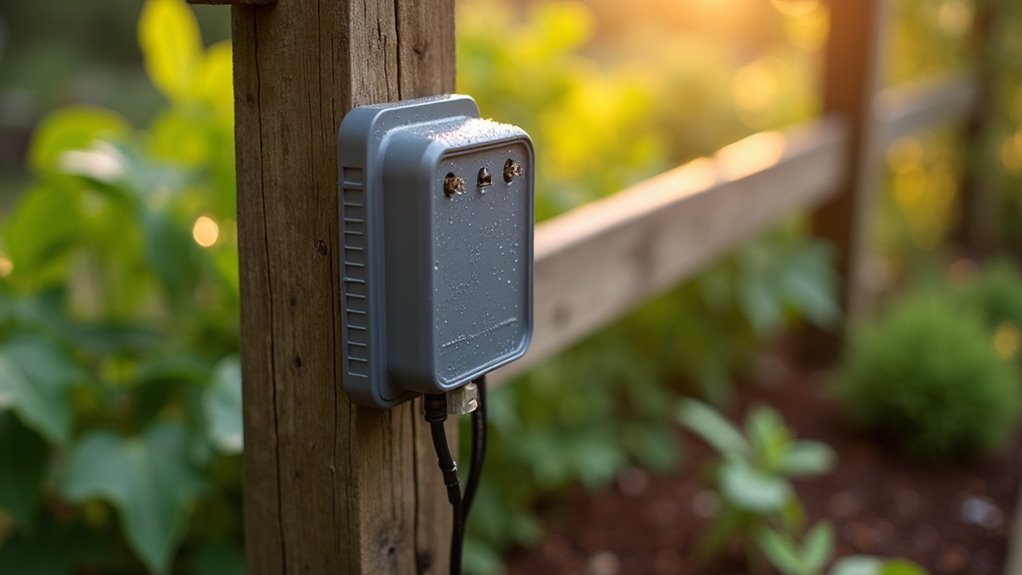
Though standard indoor mesh units excel at providing seamless connectivity within your home, they’ll quickly fail when exposed to rain, dust, and temperature extremes outdoors.
You’ll need weatherproof hardware specifically designed for outdoor environments to achieve reliable performance in your backyard.
Models like TP-Link Deco with IP65 ratings and NETGEAR Orbi with IP67-rated enclosures protect against moisture and dust infiltration.
Outdoor mesh systems with IP65 and IP67 ratings provide essential weatherproof protection against moisture and dust damage.
Advanced outdoor access points such as Ubiquiti’s U6 Mesh Pro withstand extreme temperatures while delivering seamless coverage across vast distances—up to 2,500 feet with a single unit.
These devices typically support Power over Ethernet (PoE), simplifying installation by eliminating separate power requirements.
You’ll maintain consistent WiFi connectivity regardless of weather conditions, ensuring your outdoor smart devices remain connected year-round.
Strategic Placement of Mesh Satellites
You’ll achieve maximum outdoor Wi-Fi coverage by positioning your mesh satellites near windows or exterior walls where they can broadcast signals directly into your backyard.
Elevating these devices on poles or mounting them high on walls eliminates obstructions and extends their range considerably.
Before finalizing placement, you should measure signal strength at various outdoor locations to identify weak spots that need additional satellite coverage.
Optimal Satellite Positioning
When positioning mesh satellites for ideal outdoor coverage, you’ll want to place them near windows or exterior walls where WiFi signals can more easily penetrate through building materials and reach your backyard areas.
Elevate satellites on poles or wall mounts to minimize obstacles and enhance coverage range.
Strategic best satellite positioning requires real-time performance feedback through your Orbi App to monitor signal strength and eliminate coverage gaps.
Keep satellites within 30 feet of your main router for reliable handoff, and don’t hesitate to experiment with satellite placement—small adjustments often yield dramatic improvements.
Transform your outdoor connectivity experience:
- Achieve signal strength of -60dBm or better for lightning-fast streaming and gaming
- Eliminate dead zones that frustrate family gatherings and outdoor entertainment
- Create seamless connectivity from indoor comfort to backyard paradise
Signal Strength Measurement
Measuring your WiFi signal strength transforms guesswork into precision when positioning mesh satellites throughout your outdoor spaces.
You’ll want to monitor decibel-milliwatts (dBm) readings, aiming for ideal connectivity between -60dBm and -30dBm. Anything below -80dBm signals poor performance that’ll create frustrating dead zones.
Start by conducting a thorough site survey of your backyard, checking signal strength at various locations where you need outdoor WiFi coverage. Use your smartphone’s WiFi analyzer app or your mesh system’s built-in tools to gather readings.
Position your mesh satellites strategically based on these measurements, placing them near windows or exterior walls for maximum signal penetration.
Don’t set and forget—regularly recheck signal strength and adjust satellite positions accordingly. This ongoing enhancement guarantees you maintain a seamless connection throughout your entire outdoor area.
Power Options for Outdoor Access Points
Since outdoor access points require reliable power in locations that may lack convenient electrical outlets, understanding your power options becomes essential for successful installation.
You’ll find two primary methods to power your outdoor access points effectively.
Power over Ethernet (PoE) delivers both data and electricity through a single Ethernet cable, simplifying your installation process considerably. Most outdoor access points support IEEE 802.3at PoE, eliminating the need for separate power sources while achieving coverage distances up to 2,500 feet.
Alternatively, AC power supplies offer flexibility when running Ethernet cables isn’t practical. Modern outdoor access points feature weather-resistant enclosures protecting against harsh conditions.
Your power options reveal:
- Freedom to extend WiFi reach anywhere
- Confidence in weather-resistant performance
- Simplicity through streamlined installations
Setup Process for Backyard Mesh Networks
Although extending your mesh network outdoors presents unique challenges, you can achieve reliable backyard WiFi coverage by strategically positioning your existing satellite units and adding dedicated outdoor nodes.
Begin setup by placing satellite units near exterior walls or windows to maximize signal strength penetration. Mesh systems like NETGEAR Orbi offer user-friendly apps that streamline outdoor connectivity configuration.
Elevate your satellite units and eliminate obstructions to enhance coverage throughout your outdoor space. For larger backyards, you’ll need additional satellites to prevent dead zones and maintain consistent performance.
Once installation’s complete, regularly monitor your network through the mesh system’s app to identify weak spots and adjust satellite placements for ideal outdoor connectivity.
Optimizing Signal Strength and Coverage Range
You’ll need to focus on three critical areas to maximize your mesh network’s performance in outdoor spaces.
Strategic access point placement, accurate signal strength measurement, and understanding environmental interference will determine whether your backyard WiFi delivers reliable coverage or frustrating dead zones.
Let’s examine how each factor impacts your network’s reach and consistency.
Strategic Access Point Placement
When expanding your mesh WiFi network to cover outdoor spaces, the placement of strategic access points becomes the critical factor that determines whether you’ll enjoy seamless connectivity or frustrating dead zones.
Your WiFi signal strength and coverage range depend entirely on positioning these devices to overcome obstructions and environmental barriers.
To maximize your mesh system’s performance, focus on these essential placement strategies:
- Position near windows or exterior walls – This minimizes signal-blocking obstructions between your indoor and outdoor access points.
- Elevate your devices – Mount access points on poles or high surfaces to improve signal propagation and reduce ground-level interference.
- Maintain ideal spacing – Keep devices within 30-50 feet of each other while avoiding unnecessary overlap that wastes coverage potential.
Measuring Signal Strength Performance
Once you’ve positioned your mesh access points, measuring signal strength becomes your most reliable method for validating whether your outdoor expansion delivers the performance you need.
You’ll want to achieve -60dBm to -30dBm for ideal outdoor coverage. The Orbi app provides real-time monitoring, letting you check signal strength across your backyard and identify weak spots immediately.
If you’re seeing -80dBm or lower, your WiFi signal isn’t strong enough for reliable outdoor use. This indicates you need to adjust satellite placement, ideally positioning mesh satellites near windows or exterior walls to minimize obstruction from dense materials.
Don’t hesitate to experiment with different locations, as environmental factors like trees can greatly impact signal propagation throughout your outdoor space.
Environmental Interference Factors
Environmental obstacles present the biggest challenge to maintaining strong mesh WiFi signals outdoors.
Environmental factors like trees, walls, and buildings create obstructions that weaken your network’s reach. You’ll need to position mesh satellites strategically closer to outdoor areas where coverage matters most.
Weather conditions add another layer of complexity. Rain and snow can interfere with signal transmission, making weather-resistant outdoor access points essential for consistent connectivity.
You’ll find that elevating your satellite units near windows or exterior walls improves line-of-sight and reduces signal degradation.
Consider these critical placement strategies:
- Your family gatherings won’t suffer from dead zones when you position satellites thoughtfully around obstructions.
- Your outdoor entertainment dreams become reality with properly elevated mesh units.
- Your investment pays off through weather-resistant equipment that maintains connectivity year-round.
Supporting Multiple Devices Simultaneously
As modern households continue to embrace smart technology, mesh WiFi networks excel at supporting over 150 devices simultaneously, making them perfect for homes packed with smartphones, tablets, smart home devices, and streaming equipment. Advanced mesh systems like NETGEAR Orbi optimize network efficiency in traffic-dense environments, ensuring your connected devices maintain stable connections.
| Device Category | Supported Count | Performance Level |
|---|---|---|
| Smart Home Devices | 50+ | Excellent |
| Streaming Equipment | 20+ | High-Quality 8K |
| Mobile Devices | 30+ | Seamless Roaming |
Tri-band WiFi configurations allocate dedicated bandwidth channels, preventing congestion when multiple devices stream simultaneously. Ubiquiti UniFi Access Points handle demanding applications like gaming and 8K streaming without performance degradation. You’ll experience consistent connectivity as devices seamlessly roam between indoor and outdoor coverage areas.
Seamless Indoor-Outdoor Connectivity
Modern mesh WiFi systems break down the barriers between indoor and outdoor connectivity by deploying strategically positioned satellite nodes that extend your network’s reach well beyond your home’s walls.
NETGEAR Orbi systems excel with tri-band and quad-band satellite access points featuring directional antennas that optimize signal strength and eliminate dead zones in backyards and gardens.
Your unified network automatically connects devices to the strongest signal as you move between spaces, ensuring uninterrupted internet access for streaming and smart home management.
Strategic placement near windows greatly enhances outdoor coverage up to 2,500 feet.
- Never miss important video calls while relaxing on your deck
- Stream movies seamlessly during backyard gatherings
- Control smart sprinklers effortlessly from your garden
Managing Your Extended Network
Once you’ve established your extended mesh network, maintaining peak performance requires ongoing monitoring and strategic adjustments through your system’s dedicated management app.
Most mesh systems include intuitive apps like Orbi that let you monitor network performance without technical expertise. You’ll want to regularly check signal strength throughout your backyard using a signal strength meter, targeting readings between -60dBm to -30dBm for reliable connectivity.
Target signal strength readings between -60dBm to -30dBm throughout your backyard for optimal mesh network performance and reliable connectivity.
Position your satellite nodes strategically by elevating them near windows or walls to maximize signal penetration into outdoor spaces.
When you discover WiFi dead spots, don’t hesitate to reposition existing satellites or add new ones. The app’s real-time monitoring features help you identify coverage gaps quickly, ensuring your extended network delivers consistent performance across your entire property.
Real-World Performance and Reliability
While theoretical specifications provide useful benchmarks, actual backyard performance depends on how your mesh system handles real-world obstacles like trees, outdoor furniture, and weather conditions.
Mesh systems like NETGEAR Orbi demonstrate impressive real-world performance, extending WiFi coverage up to 2,500 feet in outdoor spaces. You’ll experience stable internet speeds and reliable connections even at distances exceeding 500 feet from your main router.
Here’s what makes the difference in your backyard experience:
- Uninterrupted streaming during family movie nights under the stars
- Seamless video calls that keep you connected with loved ones anywhere in your yard
- Lag-free gaming sessions on your patio without frustrating disconnections
Advanced tri-band and quad-band technology automatically connects your devices to the strongest available signal, ensuring consistent performance throughout your outdoor spaces.
Cost Considerations for Outdoor Mesh Expansion
Expanding your mesh WiFi network outdoors requires a significant financial investment that varies dramatically based on your coverage needs and chosen equipment.
Basic setups start around $129 for a single satellite unit, while extensive outdoor areas coverage can exceed $1,700 with multiple access points and accessories.
Outdoor mesh WiFi expansion costs range from $129 for basic single-unit setups to over $1,700 for comprehensive multi-access point coverage.
Each additional satellite costs $179-$250, directly impacting your total investment.
You’ll need outdoor-rated cables ($10-$30) for stable connections and should consider Power over Ethernet adapters at $15 each to simplify installation and reduce power requirements.
While premium systems like NETGEAR Orbi demand higher upfront costs, they offer future-proofing benefits and lower long-term management expenses.
These cost considerations make planning essential for successful outdoor mesh WiFi network expansion.
Frequently Asked Questions
How Can I Extend My Wifi Signal in My Backyard?
You can extend your WiFi signal by installing a mesh system with satellites near exterior walls, using outdoor-rated access points, or implementing PoE technology for weather-resistant coverage throughout your yard.
Can Mesh Wifi Be Used Outdoors?
Yes, you can use mesh WiFi outdoors. Many systems feature weather-resistant enclosures with IP65 ratings, protecting against dust and moisture while delivering strong signals for your outdoor smart devices and streaming needs.
What Is a Major Disadvantage of a Mesh Network?
You’ll face higher upfront costs since mesh networks require multiple access points instead of a single router. You’re also dealing with potential latency issues from signal handoffs between nodes.
How Do I Expand My Mesh Wifi?
You’ll expand your mesh WiFi by adding satellite units strategically throughout your space. Place them near windows or external walls, use your system’s mobile app to optimize positioning, and guarantee proper spacing for seamless coverage.

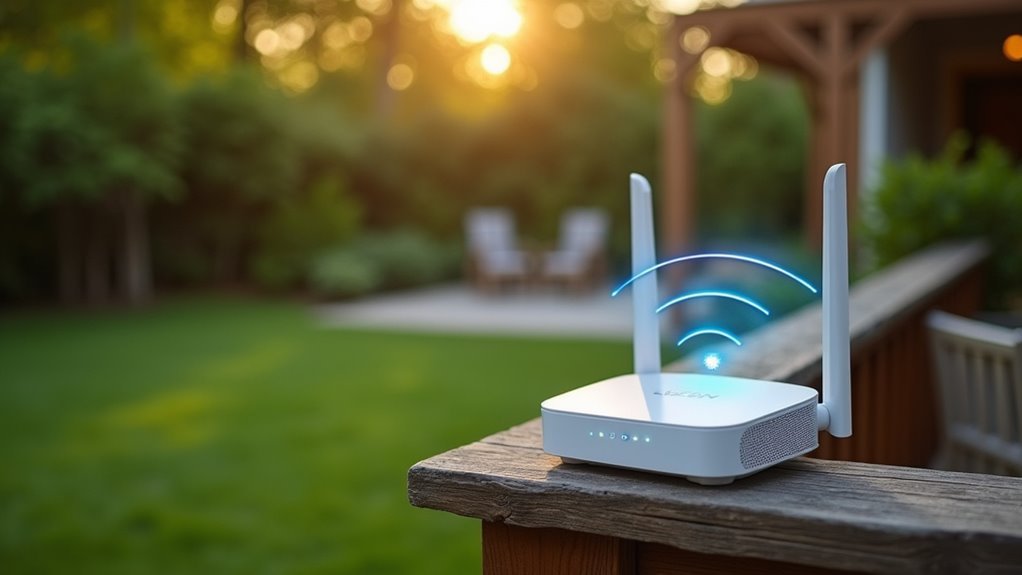
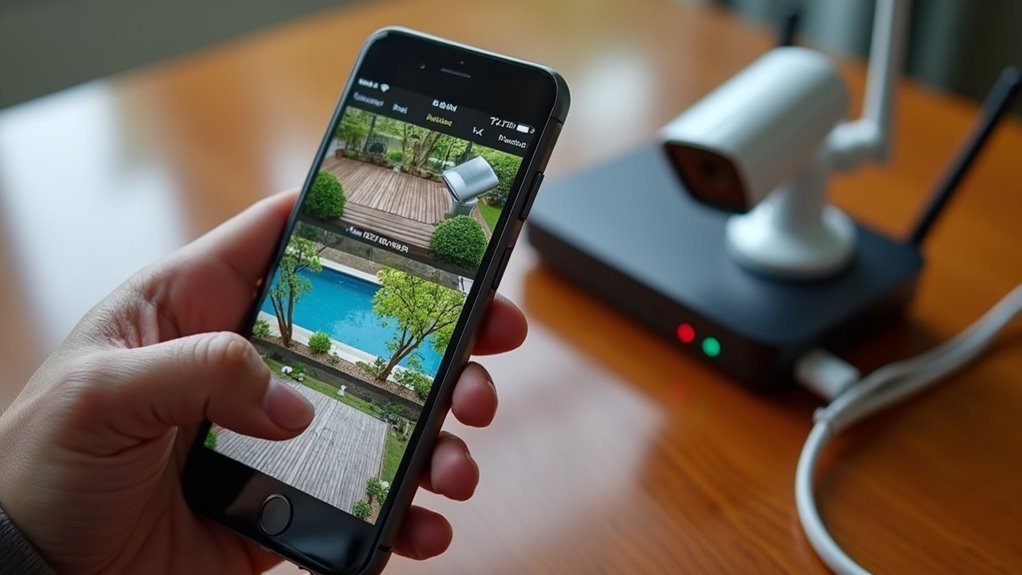

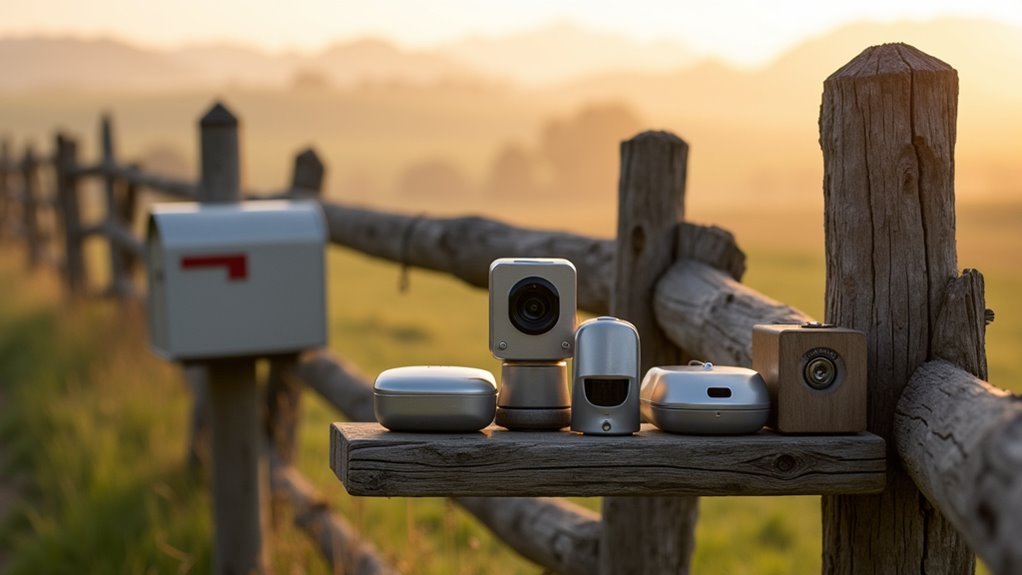
Leave a Reply